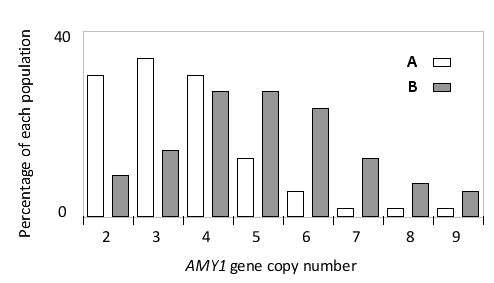Question 54
(Short Answer)
The copy number of some human genes, such as the salivary amylase gene AMY1, varies greatly between different individuals. The salivary amylase breaks down some of the dietary starch into smaller sugars. In the case of AMY1, a positive correlation has been observed between the copy number and the amount of amylase in the saliva. Gene copy number per diploid genome can be estimated by performing a quantitative polymerase chain reaction (PCR) using primers specific to the gene of interest. You have performed such PCR experiments on samples from two human populations that have traditional diets with low and high starch levels, respectively, and have plotted the data in the histogram below. Which population (A or B) in the histogram is likely to be the one with traditionally higher dietary starch? Write down A or B as your answer. 
Answer
Since the correlation of gene copy numb...
View full Answer